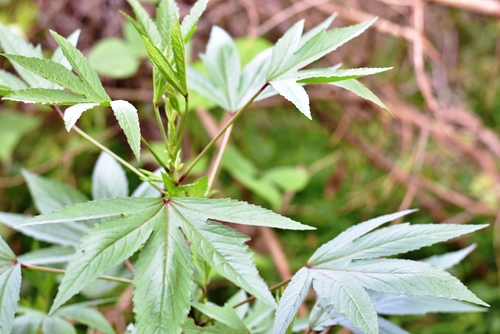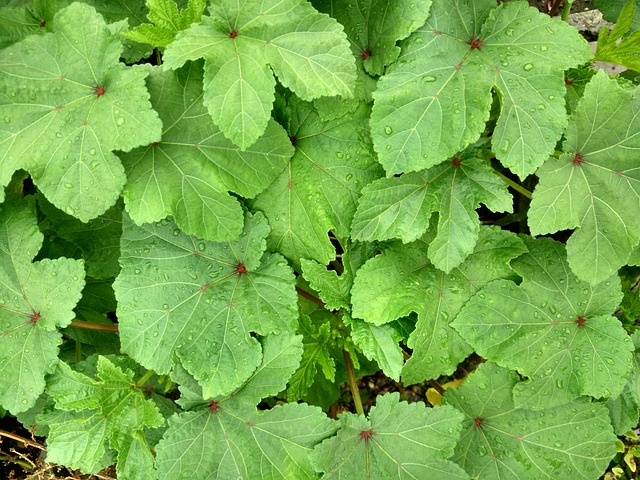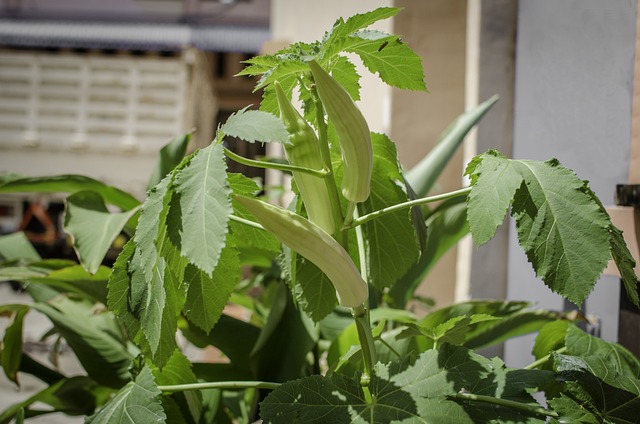Yellowing okra leaves can be a sign of a problem with your plant. If you’re noticing your okra leaves turning yellow, it’s important to identify the cause so you can take steps to fix the issue. There are several common reasons why okra leaves may turn yellow, including over or under-watering, poor soil quality, nutrient deficiencies, pests, and disease.
Identifying the cause of yellowing okra leaves can be a bit of a puzzle, but by examining your plant and its growing conditions, you can often narrow down the problem.
If you’re unsure what’s causing the yellowing, it may be helpful to consult a gardening expert or take a sample of the plant to a local nursery for analysis. Once you’ve identified the cause of the yellowing, you can take steps to address the issue and get your okra plant back to health.
Key Takeaways
- Yellowing okra leaves can be a sign of a problem with your plant, such as over or under-watering, poor soil quality, nutrient deficiencies, pests, or disease.
- Identifying the cause of yellowing okra leaves can be challenging, but examining your plant and its growing conditions can often help narrow down the problem.
- Once you’ve identified the cause of the yellowing, you can take steps to address the issue and get your okra plant back to health.
You will also like these other popular posts in this category:
- Why Are My Morning Glory Leaves Turning Yellow?
- Why Are My Lavender Leaves Turning Yellow?
- Why Are My Jasmine Leaves Turning Yellow?
Identifying Yellowing Okra Leaves

Yellowing of Okra leaves can indicate a problem with the plant that needs attention. Here are some signs to look out for:
- Yellow Leaves: Yellowing of the leaves is usually the first sign of a problem. The yellowing can start from the tips of the leaves or the veins and spread to the rest of the leaf.
- Browning of Leaves: As the problem progresses, the yellowing can turn into browning of the leaves. The brown spots can be irregular in shape and size, and the leaves may start to curl or wilt.
- Pale Leaves: In some cases, the leaves may turn pale instead of yellow. The undersides of the leaves may also turn yellow or brown.
It’s essential to identify the underlying cause of the yellowing to address the issue properly. Here are some possible causes of yellowing Okra leaves:
- Overwatering or Underwatering: Overwatering or underwatering can cause yellowing of the leaves. The soil should be moist but not waterlogged.
- Inadequate Sunlight: Okra plants require plenty of sunlight to grow and thrive. If they don’t get enough sunlight, the leaves can turn yellow.
- Poor Soil Quality: The soil should be rich in nutrients and have good drainage. Poor soil quality can lead to yellowing of the leaves.
- Nutrient Deficiency: A lack of essential nutrients such as nitrogen, potassium, and magnesium can cause yellowing of Okra leaves. These nutrients are vital for the plant to produce chlorophyll, which is essential for photosynthesis.
- Pests and Diseases: Pests such as aphids, spider mites, and whiteflies can cause yellowing of the leaves. Diseases such as Fusarium wilt and Anthracnose can also cause yellowing of the leaves.
Okra Leaves Turning Yellow – 5 Common Problems
Yellowing okra leaves can be a sign of a problem with the plant’s health. It is important to identify the cause of the yellowing leaves to prevent further damage to the plant.
1. Nutrient Deficiencies
One of the most common causes of yellowing okra leaves is a lack of essential nutrients such as nitrogen, potassium, and magnesium. These nutrients are vital for the plant to produce chlorophyll, which is essential for photosynthesis. A lack of these nutrients can lead to yellowing of the leaves, stunted growth, and poor fruit production.
2. Watering Issues

Overwatering or underwatering can cause yellowing of okra leaves. Overwatering can lead to root rot and nutrient deficiencies, while underwatering can cause the plant to wilt and eventually die. It is important to water the plant regularly and ensure that the soil is well-drained.
3. Pest Infestations
Pests such as aphids, whiteflies, and caterpillars can cause yellowing of okra leaves. These insects feed on the sap of the plant, which can lead to wilting and yellowing of the leaves. It is important to identify and treat pest infestations as soon as possible to prevent further damage to the plant.
4. Disease Infections
Fungal diseases such as fusarium wilt, root rot, and powdery mildew can cause yellowing of okra leaves. These diseases are often caused by poor soil conditions, overwatering, or overcrowding. It is important to identify and treat these diseases early to prevent potentially disastrous problems.
5. Environmental Factors
Environmental factors such as cold weather, frost, lack of sunlight, and soil temperature can also cause yellowing of okra leaves. It is important to ensure that the plant is grown in optimal conditions, with adequate sunlight and soil quality.
Okra Plant Care Tips
1. Proper Watering
Okra plants require consistent moisture to thrive, but overwatering can lead to yellowing leaves. Gardeners should aim to keep the soil consistently moist but not waterlogged.
One way to ensure proper watering is to use a moisture meter to monitor the soil’s moisture level. Watering should be done at the base of the plant, avoiding the leaves. Shallow and frequent watering should be avoided as it encourages shallow root growth.
2. Soil and Fertilization
Okra plants grow best in well-drained soil with a pH level between 6.5 and 7.5. Gardeners should cultivate the soil to a depth of 12 inches and incorporate organic matter such as compost or well-rotted manure to improve soil structure and fertility.
Okra plants require adequate nutrition to produce chlorophyll, which is essential for photosynthesis. Gardeners should use a balanced fertilizer with equal parts nitrogen, phosphorus, and potassium to promote healthy growth and yield.
3. Pest Control

Okra plants are susceptible to pests such as aphids, spider mites, and whiteflies. Gardeners should monitor their plants regularly and use natural pest control methods such as beneficial insects or insecticidal soap to prevent infestations.
4. Disease Prevention
Okra plants are prone to diseases such as fusarium wilt and root rot. Gardeners should practice crop rotation and avoid planting okra in the same spot more than once every four years to reduce the level of disease in the soil.
Using transplants instead of seeds can also help prevent disease. Gardeners can also improve the plant’s natural resistance to disease by using compost tea, which contains beneficial microorganisms that promote nutrient availability and disease resistance.
Okra Companion Planting
Companion planting is the practice of growing different crops together for mutual benefits. When it comes to okra, there are some plants that can help it grow better and healthier, while others can harm it.
Here are some of the best and worst companion plants for okra:
Best Companion Plants for Okra
1. Corn
Corn is an excellent companion plant for okra. It provides shade for the okra plants during the hottest part of the day and helps to retain moisture in the soil. In return, the okra plants provide a natural trellis for the corn to climb.
2. Onions
Onions are another great companion plant for okra. They help to repel pests that can damage the okra plants, such as aphids and spider mites. Onions also improve the flavor of okra and can help to keep the soil free of harmful bacteria.
3. Marigolds
Marigolds are a popular companion plant for many vegetables, including okra. They help to repel nematodes, which are microscopic worms that can damage the roots of plants. Marigolds also attract pollinators, such as bees and butterflies, which can improve the yield of okra.
Worst Companion Plants for Okra
Cucumbers
Cucumbers are not a good companion plant for okra. They both require a lot of water, and planting them together can lead to competition for resources. Cucumbers can also attract cucumber beetles, which can damage the okra plants.
Conclusion

There are several reasons why okra leaves turn yellow. Overwatering or underwatering the plant can cause stress and lead to yellowing and wilting of the leaves. The quality of the soil and the level of nutrients in it can also affect the color of the leaves.
If the soil lacks essential nutrients such as nitrogen, potassium, and magnesium, it can cause yellowing of the leaves. Pests and diseases can also cause yellowing of the leaves.
To prevent yellowing of the leaves, it is essential to provide adequate water and nutrients to the plant. Water the plant deeply and thoroughly, allowing water to reach the root zone. Avoid shallow and frequent watering, as it encourages shallow root growth. Use a high-quality soil that is rich in nutrients, and fertilize the plant regularly.
It is also important to identify and treat any pests or diseases that may be affecting the plant. Regularly inspect the plant for signs of damage or infestation, and take appropriate measures to control the problem.
Frequently Asked Questions
What causes yellowing of okra leaves?
Yellowing of okra leaves can be caused by a variety of factors, including overwatering, underwatering, inadequate sunlight, poor quality of soil, low levels of nutrients or pests.
When okra plants are underwatered, they become dehydrated and unable to absorb nutrients, leading to yellowing and dryness of leaves. On the other hand, overwatering can cause root rot and prevent the plant from absorbing nutrients, leading to yellowing of leaves.
How to prevent yellowing of okra leaves?
To prevent yellowing of okra leaves, it is important to maintain a consistent watering schedule and avoid overwatering or underwatering. The plant should be exposed to adequate sunlight and planted in well-drained soil.
Regular fertilization with a balanced fertilizer can also help prevent nutrient deficiencies that can cause yellowing of leaves.
What are the common reasons for yellow spots on okra leaves?
Yellow spots on okra leaves can be caused by a variety of factors, including fungal or bacterial diseases such as leaf spot or powdery mildew.
Pests such as aphids or spider mites can also cause yellow spots on leaves. Overexposure to sunlight or nutrient deficiencies can also cause yellow spots on leaves.
What are the signs of overwatering okra plants?
Signs of overwatering in okra plants include yellowing of leaves, wilting, root rot, and a musty odor. Overwatering can cause the roots to become waterlogged and prevent the plant from absorbing nutrients, leading to yellowing of leaves.
How to treat okra leaves that are turning brown?
Brown spots on okra leaves can be caused by fungal or bacterial diseases such as anthracnose or bacterial leaf spot. To treat okra leaves that are turning brown, it is important to remove and dispose of infected leaves and avoid overhead watering. Fungicides or bactericides can also be applied to prevent further spread of the disease.
What are the possible reasons for okra leaves curling?
Okra leaves can curl due to a variety of reasons, including insect infestations, nutrient deficiencies, overwatering, or exposure to extreme temperatures.
Pests such as aphids or spider mites can cause leaves to curl, while nutrient deficiencies such as nitrogen or potassium can cause leaf curling. Overwatering or exposure to extreme temperatures can also cause leaf curling in okra plants.

Hey, I’m Lisa and I’ve been an avid gardener for over 30 years. I love writing, talking and living in the garden! Feel free to connect with me on my socials below

